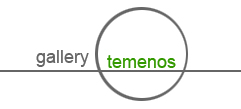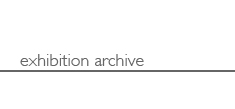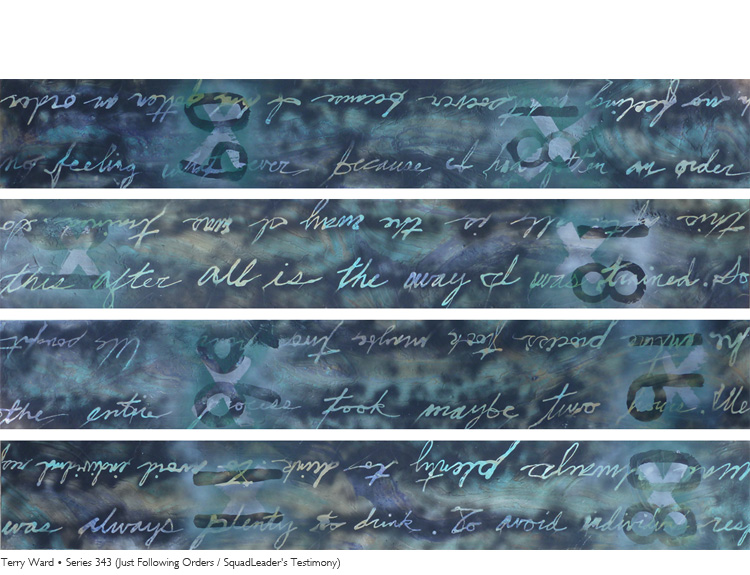Series 343 (Just Following Orders / SquadLeader's Testimony)
Pictures inspired by the awful and trite replies to Allied prosecutors by perpetrators of the Holocaust. So often the many people behind the society-wide mass-murder enterprise spoke of their grizzly tasks blandly as if facing another long day of workplace routine. Panels bear quotes (sometimes paraphrased) like (I had) "no feeling whatsoever because I had gotten an order" or "this after all is the way I was trained" and others. The words and numbers are in English because the picture is an English-language picture --though one could imagine the English-language courtroom reporter of the period taking dictation. Meanings of the numbers are purposefully ambiguous: maybe ages of memorable victims, maybe brigade numbers, or incident-deathcounts, or numbers or bodies in various mass-graves, or prisoners' numbers. Multi-panel OmniDirectional painting group; panels composed and wired to hang at any angle. Dimensions variable; each panel (~10 lbs) size 78"x12" (6.5ft x 1ft). Oil, ExPaint, latex, acrylic, spraypaint, SPOW, ExPainted ManuscriptDrips on panels (aka mixed media). |
Terry Ward Art by Terry Ward (AKA GrumpyVisualArtist) hangs in Jimmy Carter's secure conference room at The Carter Center, is in the collection of a Smithsonian affiliate gallery, and is in the personal collections of Al Gore and the late Cy Twombly. Ward paintings have hung within sight of creations by museum-grade artists George Rickey, Martin Puryear, Kenneth Snelson, and Arnoldo Pomodoro. Ward art has been exhibited at the New York Mercantile Exchange in the WTC/WFC complex, at MoMA's 2013 "Abstract Currents" "Pop Rally" event, at the Los Angeles Convention Center, at the Dallas Aurora Art Fair, and at Washington DC's Artomatic X art fair. Digital freeway billboards hosted Ward art images in Chicago, LA, New Orleans, Atlanta, and elsewhere [ http://bit.ly/YWSQKz ]. Ward seeks gallery representation in NYC and in DC. NYC group show activity included appearances at: Family Business Gallery, Sloan Fine Art, RH Gallery, and ArtCurrents.
Most post-2007 Terry Ward art is non-representational abstract painting upon same-sized panels in series groups [ http://bit.ly/1aiKR0I ]. Usually there are four similar panels --sometimes just two, sometimes up to twelve. Ward considers each panel to be a unique piece capable of being hung and sold on its own. Also, it may be combined by curators or patrons with other Ward panels --even from different series. The mixes and art "mash-ups" generate new possibilities [ http://bit.ly/19xT1Qx ]. The modular-mashup mixability of Ward's art seems to be new to painting. (In theory, all Ward art could mix in a 500-foot uberMashUp.) Most Ward art is OmniDirectional: it is purposefully composed and wired to hang at any angle [ http://bit.ly/1aZEHTX ]. Officially, Ward welcomes the Relational Aesthetics idea of viewers rearranging the panels while they are on exhibit. Ward also encourages patron-remixing: panels may be bought or sold individually or in groups or remixed as buyers see fit. Tilting or inverting panels? Fine. (Of course, for curatorial or liability reasons, venues usually prohibit such behavior; visitors should check with gallery staff before handling the art themselves.)
Ward said: "I just recognize that the 'meaning' of any art already exists only inside the viewer/s mind; I might envision a certain piece, but even as I make it, the finished art will differ in some ways from my first intent --any artist who denies that happens is probably lying." Ward continued, "so the art is already one degree 'off' from the artist's original intent, even as the artist creates the art; and as soon as someone else looks at it, then the viewer's whole aesthetic and cultural and personal experience will influence the interpretation --there is no way for an artist to 'control' that." Ward concludes, "so I look that in the eye and say, 'bring it on' --it's fine.... part of my artistic process is to 'embrace' that." Even though composing pictures to "work" at any angle is more challenging than composing conventionally-oriented paintings, Ward smiles at the idea of some enterprising visitor getting permission from gallery staff to flip a panel upside-down.
Terry Ward is a "nomadic" painter who creates while outside in secluded grassy lots, certain neglected parking areas, and in (post-/)industrial blank land. Art-making sites were in Brooklyn's Red Hook neighborhood (where Ward is also a web-volunteer for Superfund site/industrial canal canoeing club called the Gowanus Dredgers), Jersey City's manufacturing/chemical-mixing areas, and also in Virginia [ http://bit.ly/18PXzGK ].
Ward's process is messy [ http://bit.ly/1btfyE9 ]. Housepaint, acrylic, oil, and gallons of water move around. Spraypaint goes on --or comes off. A Ward process called ExPaint is all about removing paint and revealing underlying layers. Some Ward processes are unusual [ http://bit.ly/15mKWCq ]. Ward's student-era thesis-related exhibits were at James Madison University, Mary Baldwin College, and Bridgewater College galleries. For a few years, Ward was an art teacher in public schools and also at a private facility in the Berkshires. Ward does occasional art-writing, with publications in the Huffington Post, In The Art World, and The New York Art World.
http://grumpyvisualartist.blogspot.com |






